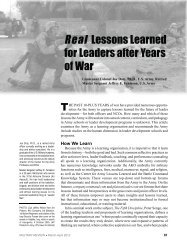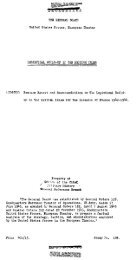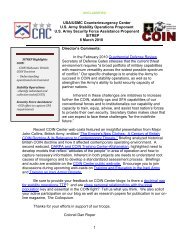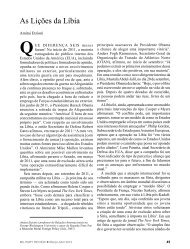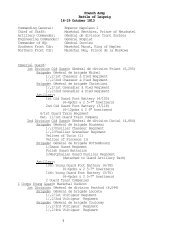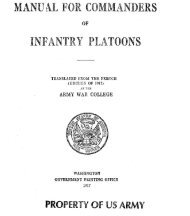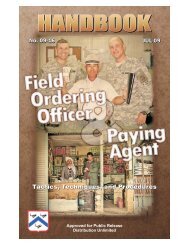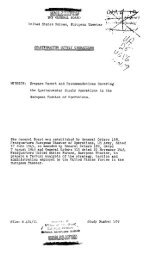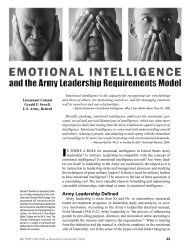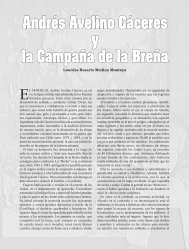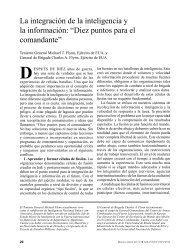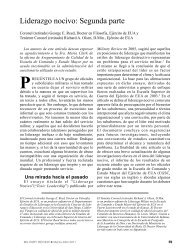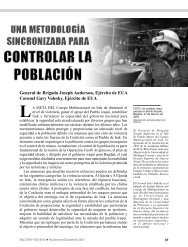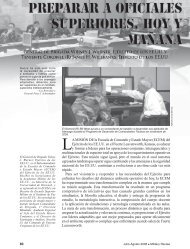Armor Magazine Counterinsurgency Selected Works - US Army
Armor Magazine Counterinsurgency Selected Works - US Army
Armor Magazine Counterinsurgency Selected Works - US Army
You also want an ePaper? Increase the reach of your titles
YUMPU automatically turns print PDFs into web optimized ePapers that Google loves.
<strong>Counterinsurgency</strong><br />
and Core Competencies<br />
by BG Donald M. Campbell, Jr., Commanding General, U.S. <strong>Army</strong> <strong>Armor</strong> Center<br />
“On 25 July 2008, Command Sergeant<br />
Major (CSM) Otis Smith, relinquished his<br />
position as the <strong>Armor</strong> Center’s 20th Command<br />
Sergeant Major after 34 years of<br />
dedicated service to our Nation and our<br />
<strong>Army</strong>. During his time at the <strong>Armor</strong> Center,<br />
CSM Smith proved to be an exceptional<br />
leader who cares about soldiers. His<br />
departure is certainly a loss to our force;<br />
however, through his leadership and guidance,<br />
he leaves our force and its soldiers<br />
better prepared to meet the challenges of<br />
the battlefield both today and in the future.<br />
As a warrior, he led, trained, taught,<br />
inspired, coached, mentored, and instilled<br />
loyalty and a fraternal brotherhood within<br />
the entire <strong>Armor</strong> community. Thank<br />
you, Otis, for keeping our mounted force<br />
on the cutting edge of the battlefield, for<br />
caring about soldiers, and for the many<br />
challenges you faced and conquered for<br />
the greater good of the <strong>Armor</strong> Force.”<br />
As we dedicate this current issue of AR-<br />
MOR to the counterinsurgent fight, I must<br />
remind the force of its need to maintain a<br />
balance between what we know as the current<br />
counterinsurgency fight and what we<br />
foresee as a future of persistent conflict.<br />
This issue compiles lessons learned from<br />
current operations in Iraq and Afghanistan<br />
and past operations in Vietnam. However,<br />
as we learned, specifically, from the<br />
lessons of the Israelis during their battle<br />
with Hezbollah in Southern Lebanon, we<br />
must not lose sight of what the armored<br />
force brings to the battlefield during highintensity<br />
operations. In short, we must<br />
strike a balance between counterinsurgency<br />
training and our core competencies.<br />
The term “core competencies” refers to<br />
all the tasks our armored systems, of<br />
which the tanker and the scout are an integral<br />
part, conduct during high-intensity<br />
operations. It also includes the tasks our<br />
armored formations must conduct to support<br />
our armored systems, which center<br />
on the protection provided by our armor,<br />
the firepower our weapons systems bring<br />
to bear, and the maneuverability of our<br />
systems. Our core competencies include<br />
operations, such as long-range precision<br />
gunnery; platoon, company, and battal-<br />
ion maneuver; logistics operations; maintenance,<br />
and command and supply discipline,<br />
which have been the cornerstone<br />
of armor for decades. Alas, we must concede<br />
that these competencies are slowly<br />
declining as we concentrate solely on<br />
counterinsurgency operations focused on<br />
the will of the people and not the destruction<br />
of an enemy.<br />
While there’s clearly nothing wrong with<br />
focusing on the current fight, I am concerned<br />
that the majority of our tank commanders<br />
have never qualified Tank Table<br />
VIII and that brigade commanders are reporting<br />
weaknesses in maintenance management,<br />
particularly services and property<br />
accountability, at the company level.<br />
It is very difficult to meet everyday requirements<br />
that increase soldier survivability<br />
and our chances of success on the<br />
battlefield, but we can achieve a healthy<br />
balance much easier than one might realize.<br />
First and foremost, the <strong>Armor</strong> School<br />
provides its Soldiers with tough, wellrounded<br />
courses that focus on full-spectrum<br />
conflicts. Each of the <strong>Armor</strong> School’s<br />
courses provides the skill-level appropriate<br />
training on tasks necessary to win the<br />
fight during counterinsurgencies and major<br />
combat operations. For example, the<br />
Master Gunner Course teaches noncommissioned<br />
officers how to identify and<br />
cor rect for deficiencies in the M1’s fire<br />
control system, and assists company commanders<br />
and battalion S3s in planning<br />
gunnery training for their units; the Scout<br />
Leader Course teaches scout leaders, from<br />
staff sergeant to lieutenant, how to be<br />
proficient in reconnaissance operations<br />
across the spectrum of conflict; and the<br />
Maneuver Captain’s Career Course trains<br />
6 out of 8 modules on conducting operations<br />
in a major combat environment. But<br />
the <strong>Armor</strong> School’s training efforts do<br />
not stop there, we must train to standard<br />
everywhere and we are currently working<br />
with TRADOC to bring mobile training<br />
teams to our Soldiers in the field.<br />
We are also developing new doctrine<br />
that spans the spectrum. Prior to the re-<br />
lease of U.S <strong>Army</strong> Field Manual (FM)<br />
3-0, Operations, we were reviewing our<br />
doctrine, and later this year, we will release<br />
FM 3-20.21, the Heavy Brigade<br />
Combat Team (HBCT) Gunnery Manual.<br />
We are also in the process of staffing FM<br />
3-90.1, The Tank and Mechanized Infantry<br />
Company/Team, and FM 3-20.98, Reconnaissance<br />
and Scout Platoon.<br />
Further, we are consistently working to<br />
improve our armored systems, such as the<br />
Abrams tank, which enable us to remain<br />
the premier armored force well into the<br />
fu ture. We also continue to explore upgrades<br />
to sights, armor packages, and ammunition<br />
to maintain our systems’ lethality.<br />
We are working to improve target identification<br />
and prevent fratricide through<br />
our work in combat identification.<br />
Finally, we have been directed to holistically<br />
review our force design updates to<br />
ensure the survivability, lethality, and capabilities<br />
of our reconnaissance formations<br />
and ensure they have the right balance.<br />
We have learned from our operations<br />
in Iraq and Afghanistan that armor<br />
and cavalry, whether it be Abrams, Bradley,<br />
or HMMWV mounted, will always be<br />
relevant and we must continue to make<br />
improvements in these systems to maintain<br />
our overmatch.<br />
As most of us realize, the current fight<br />
will eventually end; however, there is<br />
great concern that the force’s institutional<br />
knowledge base on CMETL tasks have<br />
atrophied. Therefore, it is important that<br />
we maintain balance and ensure our core<br />
tasks do not get lost to the tasks of the<br />
day. I am certain the armored force will<br />
need these skills in the future to remain<br />
the “combat arm of decision.”<br />
Forge the Thunderbolt!<br />
4 — September-October 2008



